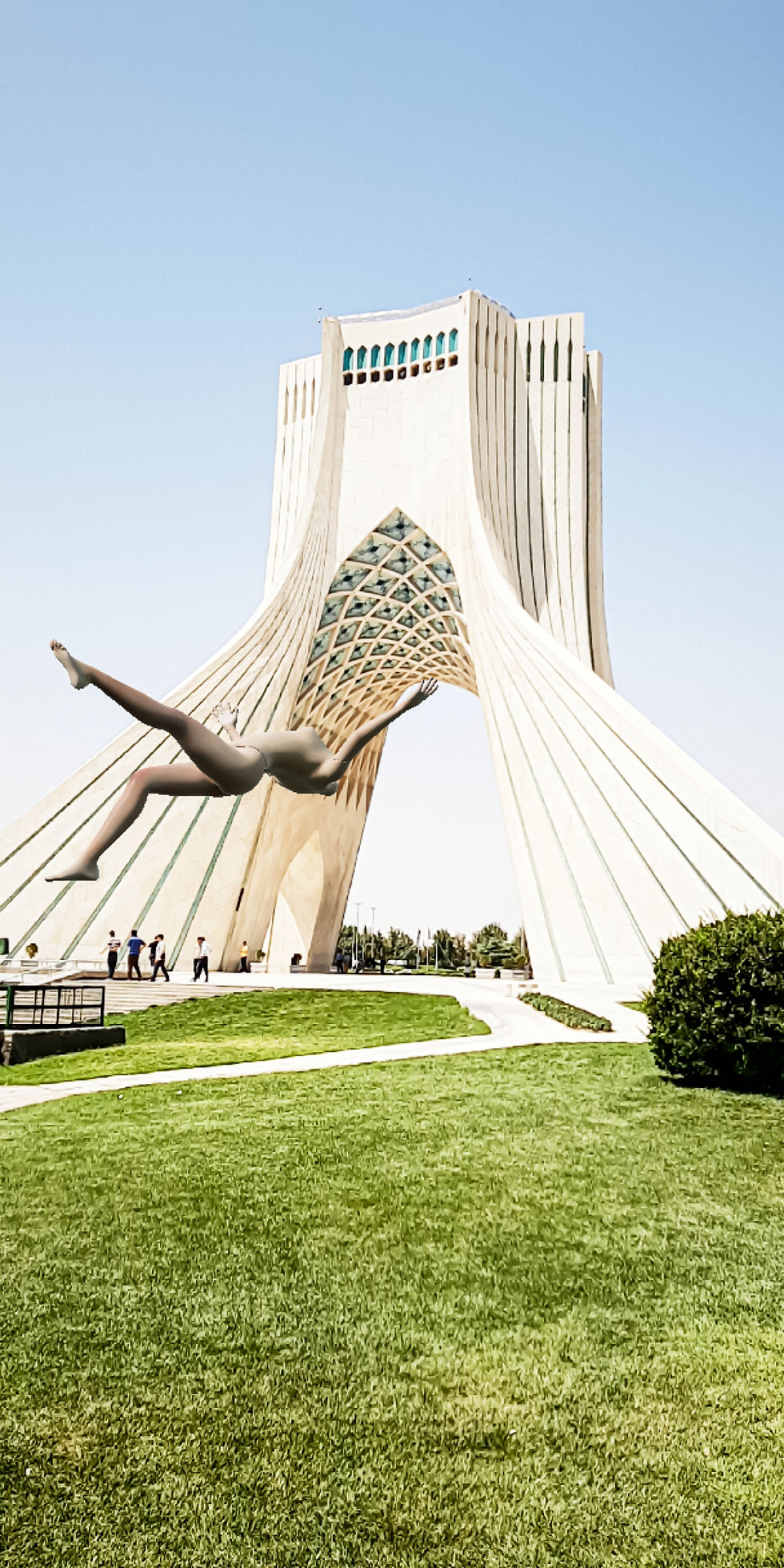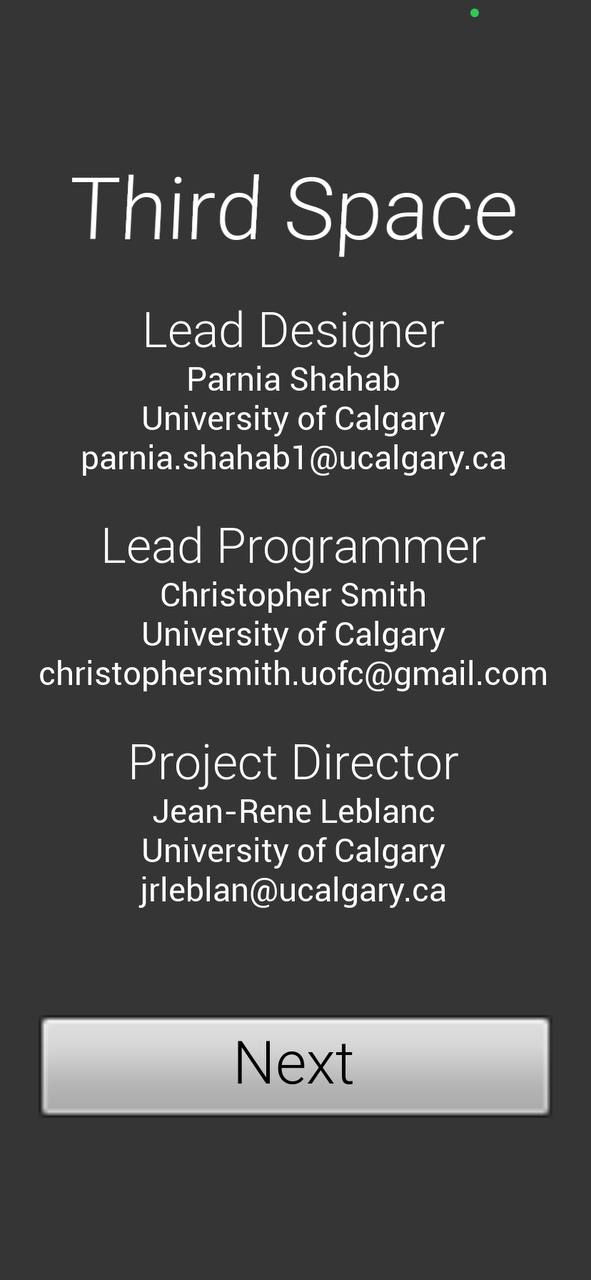PARNIA SHAHAB
Floating Bodies App & Exhibition
2022, Calgary, Canada
Exploring how augmented reality as a digital interactive environment can be adapted to study the experience of displacement
My ongoing art practice focuses on adopting digital interactive environments to study the experience of displacement. I investigate how female bodies perceive physical/social spaces, how the context shapes this perception, and how augmented reality helps study, embody, and share the experience of displacement. I designed an AR app called "Floating Bodies" and used the flexibility of virtual space to depict the "floating status of the displaced person" and designed the avatars (headless/distorted) naked female bodies to be projected into the physical space to open the dialog with the audience.
My Thesis exhibition was a collection of screenshots of the users in different parts of the world, mainly in Iran and Canada. Users’ screenshots show how each individual interprets and experiences the concept of displacement differently and at the same time within common categories with others. This project suggests attending to the embodied experience of displacement as a way to understand this phenomenon at a deeper level and help return the displaced persons to their lived status.
The exhibition also included collaborative work with Helena Hadala (RCA). The mosaic art on the floor of this atrium in contemporary Calgary is the work of Helena Hadala, a professional Canadian visual artist, in 1979. Helena is a multi-media visual artist who is inspired by Zen Buddhist philosophy and Taoism. These philosophies inform her life and her approach to the creative process. Helena created this piece in relation to the former purpose of this building as the science center. Her design shows the earth and the magnetosphere around it. A magnetosphere is the "Space" around a planet dominated by the planet's magnetic field.
In my private talk with the artist, I explained the idea of my work, and she suggested collaborative work for the floor piece since our artworks are connected conceptually at some level. The floating body in my work (my app's logo) describes the displaced person that belongs nowhere and everywhere, to an in-between space like the one represented in the mosaic art. After designing several versions for this piece, we decided to cut out the avatar from the logo so part of the original design (the world) could be visible within the floating body's shape to highlight this aspect of the work.
This collaboration was truly a great honor for me as a young artist to learn more about the dynamic world of art practices. Receiving feedback on my work and getting to know the concept of original design helped to create a stronger connection with Helena's work and this atrium as a place for my exhibition.




Third Space App
2022, Calgary, Canada
Exploring relationships between the body and transitional spaces-heterotopias
SCAN THE IMAGES HERE
"Third Space" is an ongoing research-creation that investigates the lived bodily experiences of two different contexts -my hometown Tehran and now Calgary- during the immigration process. Investigating the body as a medium to transfer data into different fields and a means of conceptual revelation helped me reassess my perception of more complex experiences of in-between space and transitional phases in my life. This body of work uses site-specificity and new technology-augmented reality- as the main methods to analyze the factors of the site and the bodily experiences. The interaction between real and virtual elements in augmented reality offers an ideal context to simulate more complex environments and analyze the emerging relationships, such as my actual existence in the new context and my virtual presence in my hometown and passing through different phases between the two. Mixed environments merge both real and virtual realms into a new space, form a single experience, and offer a high level of sensorial engagement, abstraction, and additional layers of information that enrich the user's experience.
"Third Space" app attempts to represent the lived bodily experiences through the immigration process. This trilogy works by scanning three images. Each image connects the viewer to a different virtual element. The three stages are:
-No one, Nowhere: This stage focuses on showing the contrasts between the bodily experiences of two different contexts.
-Everyone, In-between: This stage focuses on the process of adaptation and blending with the new environment.
-The few, Borderland: This stage focuses on depicting the struggles over a longer period and with broader terms such as national belonging.
Locating this work in a skywalk (Calgary +15 tunnels) also emphasizes the concept of liminal/transitional spaces that are made for passage. This interactive piece asks the users to take a moment and linger for a while to see the other dimensions of this tunnel and explore different layers of the concept.





The duet
2021, Calgary, Canada
Exploring relationships between the body, non-place, and heterotopias
This work represents research about the body's relationship to complex environments such as non-places, heterotopias, and in-between spaces. This duet is an attempt to represent the theoretical framework and the interplay between two concepts that have been processed parallel in the previous semesters (floating bodies and wrapped bodies). Using Mixed environment and site-specific performance as a method of analysis has led the outcomes of this work to a multi-dimensional project, focusing on redefining the body's relationship to complex environments. The choreography of this work responds to the body's lived experience in the context of Canada and Iran. The exhibition's format, including the live performance and stage design, responds to the theoretical ideas directly-space/places the artist lived and experienced. Performing live for the final exhibition not only highlights the relationship between the space/place but also expands the outcomes of this research by creating a third space (representation of heterotopias and non-places) and leaving an open space for the audience's imaginations.




Floating Bodies App
2021, Calgary, Canada
Exploring relationships between the body and physical/conceptual space
In this project, concept of Floating Bodies is developed in the A.R. platform to answer the research questions. This concept mainly responds to the body's perception and navigation of physical/conceptual space without considering any limitations in the context and environment. This project's primary focus is programming a floating body in space and studying users' interaction with it in different locations. The Floating bodies app, designed for IOS mobile phones, represents how the body and space interact and showcases the inner forces between them. With this app, users can experience qualities of physical space that are hidden or underappreciated. The creation of the artworks, which are a series of interdisciplinary experiences in performance art, photography, and Augmented reality app, responds to the body's various ways to inhabit, perceive, and navigate physical and cultural spaces/places in the context of Canada.




